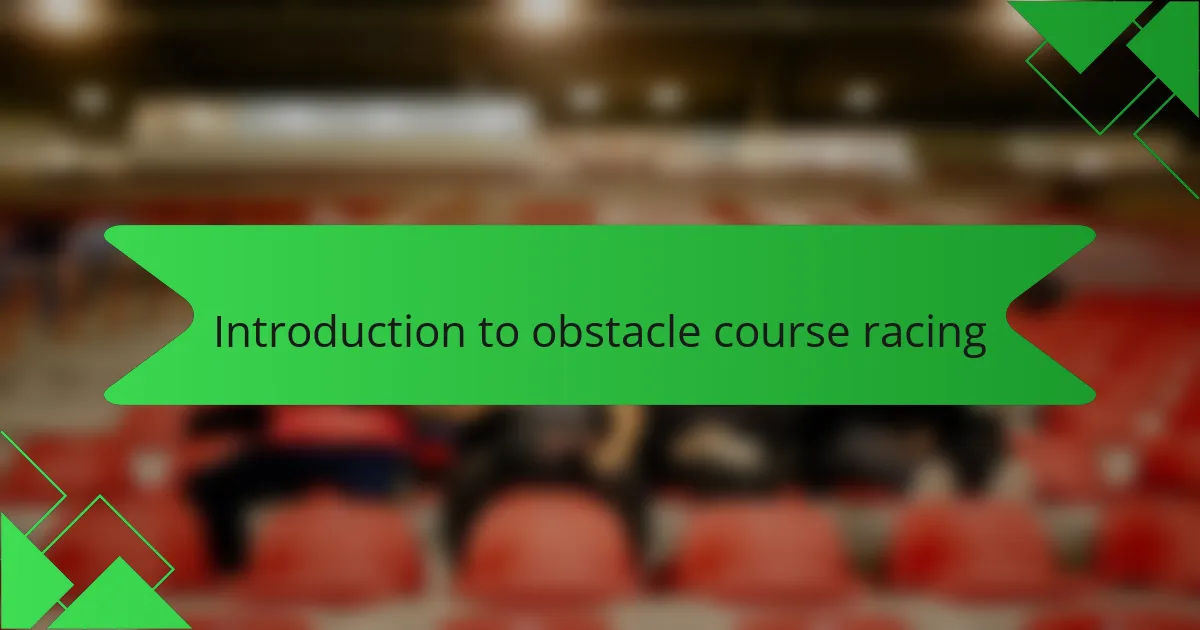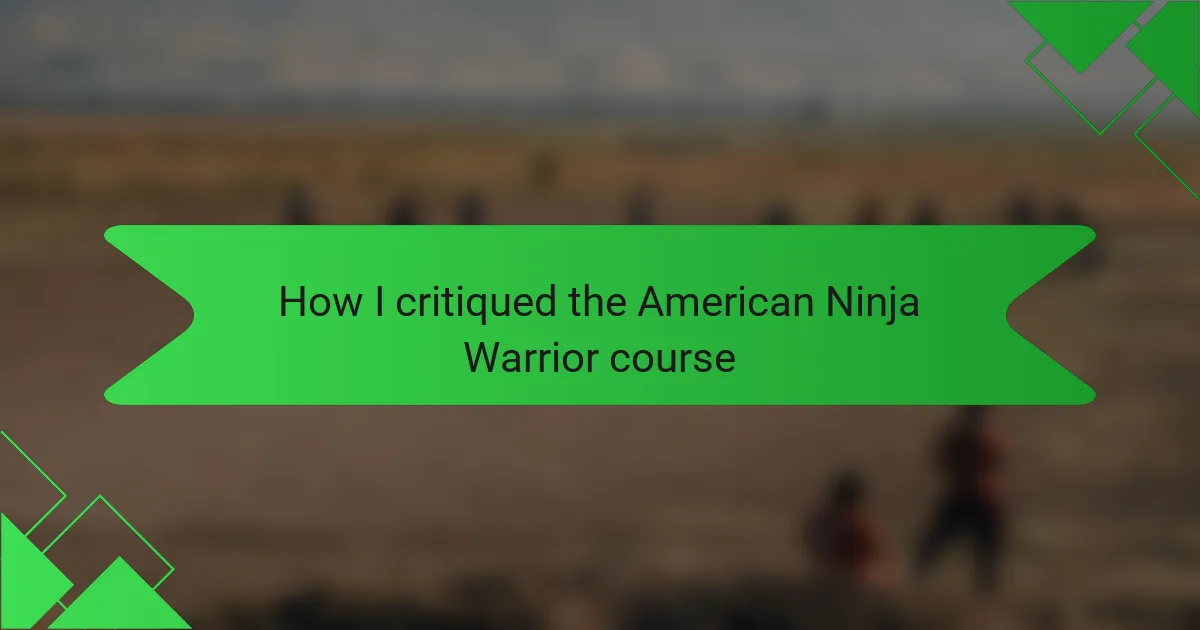Key takeaways
- Obstacle course racing (OCR) combines physical challenges and mental toughness, making each race a unique adventure.
- Designing effective courses requires balancing difficulty, ensuring variety, and maintaining smooth obstacle flow.
- Key performance tips include developing grip strength, mental resilience, and refining technique for efficiency.
- Listening to participant feedback is essential for continual improvement in course design and athlete engagement.

Introduction to obstacle course racing
Obstacle course racing (OCR) is an exhilarating sport combining running with a variety of physical challenges. From my experience, it pushes you not only physically but mentally, demanding resilience and creativity. Unlike traditional races, OCR tests your agility, strength, and problem-solving skills all at once.
What I love most about OCR is how each course tells a different story, making every race a unique adventure. It’s more than just running; it’s about facing fears and celebrating small victories over tough obstacles.
| Aspect | Explanation |
|---|---|
| Physical Challenge | Combines running with climbing, jumping, and crawling obstacles |
| Mental Toughness | Requires focus, strategy, and persistence to overcome each obstacle |
| Variety | Courses differ greatly, ensuring unique experiences every time |
| Community | Encouraging and supportive, fostering friendships and teamwork |

Understanding American Ninja Warrior courses
Understanding the American Ninja Warrior courses is crucial before diving into a critique. From my experience, these courses push athletes to test their strength, agility, and mental toughness in ways that feel both exhilarating and brutally unforgiving. I remember feeling a rush of respect and slight intimidation as I analyzed each obstacle, realizing the precision and practice required to overcome them.
| Aspect | American Ninja Warrior Course |
|---|---|
| Obstacle Variety | Extensive and inventive, designed to challenge multiple skill sets |
| Difficulty Progression | Gradual increase, culminating in extremely demanding final stages |
| Physical Demands | High, with emphasis on upper body strength and explosive power |
| Mental Challenge | Significant, requiring focus, strategy, and error-proof execution |
| Course Layout | Dynamic, often tailored for each season with unique obstacles |

Key challenges in obstacle course design
Designing an obstacle course that truly challenges athletes is no easy feat. One major challenge is balancing difficulty with accessibility; too hard, and it deters newcomers, but too easy, and it fails to push elite competitors. I remember facing a course that felt either too punishing or too simple—it left me wondering, how do designers find that perfect middle ground?
Another key struggle lies in ensuring variety without sacrificing flow. Each obstacle needs to test different skills while maintaining a smooth progression that keeps athletes engaged, not frustrated. When I critiqued the American Ninja Warrior course, I noticed how carefully the sequence built tension, making every challenge feel like a natural next step rather than a random hurdle.
Mental fatigue also plays a huge role in course design. It’s not just about physical strength; obstacles must demand sharp focus and problem-solving under pressure. I’ve been on courses where the mental challenge crept up on me unexpectedly—have you ever underestimated how exhausting thinking can be when your body’s already drained? That subtle balance is something I deeply appreciate in well-crafted obstacle courses.

Criteria for critiquing courses
When I critique an obstacle course like American Ninja Warrior’s, I start by looking at how well it balances physical difficulty with mental demands. Does the course push athletes just enough to test their limits without tipping into frustration? I find that courses too focused on brute strength often neglect the cleverness needed to strategize, and that imbalance almost feels like a missed opportunity.
Another crucial criterion is how the obstacles flow together. Have you ever tackled a course where the jumps from one challenge to the next felt jarring or, worse, anticlimactic? I think a great course tells a story through its layout, guiding you seamlessly from one test to the next, each building anticipation and requiring a fresh skill. When I watched the American Ninja Warrior stages, I admired how every obstacle seemed to naturally lead into the next, keeping me engaged even when I wasn’t physically on the course.
Variety also plays a significant role in my evaluation. A good course shouldn’t just recycle the same types of obstacles—it should surprise you, forcing you to adapt and think on your feet. From my experience, the best courses constantly evolve, mixing grip strength, balance, and explosive power in ways that keep the mind sharp and the body guessing. How often have you faced a course that felt too predictable? That’s when the excitement fades, and I always look for that spark of originality when I critique.

Personal experience with the American Ninja Warrior course
Taking on the American Ninja Warrior course was a thrilling challenge that pushed my physical and mental limits. I vividly remember the rush of adrenaline as I approached the warped wall, my heart pounding with a mix of excitement and nerves. Each obstacle demanded a different skill set, forcing me to adapt quickly and stay focused under pressure.
One moment that really stood out was struggling with the salmon ladder. It was frustrating at first, but once I finally got the hang of the timing and technique, the sense of accomplishment was incredible. This course tested not just strength, but patience and resilience in ways I hadn’t anticipated.
- The warped wall required explosive leg power and precise foot placement.
- The salmon ladder challenged upper body strength and rhythm.
- Transitioning between obstacles demanded quick mental adjustments.
- Grip endurance was critical for the hanging obstacles.
- Staying calm under pressure made a significant difference in performance.

Lessons learned from course critique
Lessons learned from course critique revealed the balance between challenge and fairness is crucial. I realized how small design tweaks can massively affect a competitor’s confidence and performance. It made me appreciate the meticulous work behind every obstacle, beyond just physical difficulty.
| Aspect | Insight |
|---|---|
| Obstacle Variety | Essential for keeping engagement high but must suit all skill levels |
| Difficulty Balance | Too hard early on can discourage, too easy can bore; pacing matters |
| Safety Measures | Non-negotiable; a well-placed safety feature builds trust and reduces anxiety |
| Visual Appeal | Aesthetics draw athletes in, boosting motivation and focus |
| Feedback Integration | Listening to participant feedback ensures continual improvement |

Tips for improving obstacle course performance
Tips for improving obstacle course performance often come down to mastering both physical skills and mental toughness. From my experience on the American Ninja Warrior course, I realized that grip strength wasn’t just helpful—it was a game-changer. Training specifically for grip endurance made those challenging obstacles feel a little less daunting. Also, pacing yourself and staying calm under pressure allowed me to correct mistakes quickly instead of getting overwhelmed.
| Skill | Why It Matters |
|---|---|
| Grip Strength | Essential for hanging and swinging obstacles; helps maintain control and conserve energy |
| Mental Resilience | Keeps you focused and adaptable during unexpected challenges on the course |
| Technique Practice | Refining movements reduces energy waste and improves efficiency |
